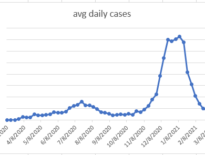Sunday, August 1, 2021

A couple of months ago I was desperately hoping that my next post about COVID-19 would be a retrospective, summarizing what we had learned and looking forward to a post-pandemic world. I am extremely ready to be done with this microscopic monster, but it is clearly not done with us.
In LA County, as well as in the US, case counts have been rapidly rising in the last few weeks. News stories warning us about the highly infectious delta variant are ubiquitous. In fact, it’s hard to find a news story in which “delta variant” is not preceded by “highly infectious”. Hospitalization rates are also climbing. Death rates are climbing nationally and will likely start climbing in LA in the next few weeks.
In the meantime, vaccination rates have slowed to a trickle. Nationwide about half the population is fully vaccinated. LA County is doing a little better, with 62% fully vaccinated. And the limiting factor on vaccination is no longer supply. Vaccines are available for the asking, free of charge, frequently with no appointment necessary. The only limitation on vaccination rate is demand.
And, if this wasn’t bad enough, stories about breakthrough cases are circulating. Breakthrough cases are COVID-19 infections in fully vaccinated people. Just when we’re trying to convince everyone that the vaccines are safe and effective, we’re hearing that the number of breakthrough cases are increasing, and that recent research shows that breakthrough cases can transmit the novel coronavirus to others. Oy vey.
So what’s a well-intended public health official to do? Los Angeles County and more recently the CDC have recommended that everyone wear masks indoors, changing a previous recommendation that only unvaccinated people need to mask inside.
The evidence for the effectiveness of face coverings in preventing COVID infectious in the community is very weak. I’m only aware of one randomized trial testing the efficacy of masking in the community (as opposed to in healthcare settings). Though the study was flawed, it showed no decrease in infections between the masked group and the control group. Nevertheless, most experts assume that masks must offer some protection, but in the absence of rigorous studies, quantifying the level of protection is difficult. Compared to vaccination the assumed level of protection from masking is much much less. Nevertheless, since these measures are independent, they should have additive benefits. So why not do both? Why not encourage vaccinated people to mask?
Keep ICU Beds Open
To answer that question, we first have to answer another broader question. What are we trying to accomplish? What is the goal of our pandemic response? Or, what should it be? Initially, when the pandemic was new, when our ICU protocols were evolving, when hospitalizations were first climbing exponentially, the goal was simply to keep from exhausting finite healthcare resources. We wanted to “flatten the curve” so that the last ICU bed, the last ventilator, the last nurse would remain available for the next patient. We did that. Even in the hardest hit areas, even with patients in New York being transferred between hospitals, no patient was turned away. There is no chance of the healthcare system being overrun this time. Half of us are vaccinated, and our inpatient protocols have improved dramatically.
Disease Eradication
Are we trying to eradicate the virus? That goal is completely unrealistic. That is impossible short of putting everyone in the world in solitary confinement for a couple of weeks. The virus will continue to circulate among humans and will join the older coronaviruses, influenza viruses, rhinoviruses that occasionally make us sick. We will no more be able to eradicate COVID than the common cold.
Minimize Bad Outcomes
Perhaps we’re trying to prevent very bad outcomes, like hospitalizations and deaths. That would be a worthwhile goal. But if that is the outcome that we focus on, we quickly realize that the current surge is almost entirely affecting the unvaccinated. Lost in the reporting of the numbers of breakthrough cases and the infectiousness of breakthrough cases is the simple fact that virtually all breakthrough cases are very very mild. The CDC tabulates breakthrough cases that have led to hospitalization or death. As of July 26, 6,587 fully vaccinated people were infected with COVID and were hospitalized or died. That’s out of 163 million fully vaccinated Americans (about half the population). When we exclude those that had asymptomatic infections and were hospitalized or died for reasons unrelated to COVID (for example someone who tests positive, has no symptoms, and then dies in a car accident) we are left with 4,641 hospitalizations and 954 deaths. That’s one death for every quarter of a million vaccinated people.
The current 7-day average of daily hospitalizations for COVID in the US is 5,475, and deaths is 305. That means more people are being admitted to US hospitals every day with COVID than all the vaccinated people that have ever been hospitalized since vaccination started. And every three days as many people die of COVID as all the vaccinated people who have died since vaccination started. That means that virtually all the hospital admissions and deaths of the current surge are among the unvaccinated. This is the simple message missing in most reporting, that we’re now experiencing two different pandemics. COVID is now a lethal plague for the unvaccinated, and usually an uncomfortable nuisance for the vaccinated.
So if we’re trying to prevent hospitalizations and deaths, we have to continue the difficult work of persuading people to get vaccinated. There is little reason to suspect that the very very few hospitalizations and deaths among the vaccinated would be significantly lowered by masking them.
Minimize Infections
Another possibility is that we’re simply trying to minimize infections for its own sake. Isn’t it worthwhile to keep the case counts low just so that fewer people are sick? Well, given that we’ve just seen that breakthrough cases in vaccinated people tend to be very mild, there are important tradeoffs to consider. How many hundreds of people should mask to prevent one person from having a cough and a runny nose for a week? Is it worthwhile mandating a weak intervention for everyone when a very effective intervention is readily available?
Which strategy might persuade an open-minded vaccine skeptic? Telling vaccinated people that they must also mask implicitly suggests that they are at risk. On the other hand, making it clear that the current surge is dangerous only for the unvaccinated emphasizes the value of the vaccine.
Prevent Future Variants
And the final, and frequently mentioned, concern of public health officials, is that the more people carry the infection, the more likely it is that more mutant variants will emerge. The fear is that a future variant will escape vaccine suppression, and we’ll be back to square one. That’s a reasonable concern, but masking Americans will not significantly decrease the global case counts. If we want to prevent the omega variant, we must help vaccinate the rest of the world. The delta variant didn’t originate in the US. Unless we cut off all international travel (please, let’s not), variant suppression has to be a global effort. That makes masks on Americans entirely irrelevant.
I’m not suggesting that individuals disobey their local mask recommendations. I now wear a mask inside. But I would like to persuade public health officials that their current course is ineffective and self-defeating. It’s ineffective because it won’t decrease severe outcomes, and self-defeating because it will decrease interest in vaccination. It is also needlessly terrifying my patients. My average 70-something-year-old patient is now uncertain that her vaccine is protecting her, when she should be confident that it is. She is emailing me to ask about boosters. (Not yet. Stay tuned.) She is wearing masks outdoors. (Stop that. There is no COVID transmission outside.) And she lives in fear of contracting COVID, when most likely it would be no worse than a severe cold. (An important exception is vaccinated people with immunosuppressive diseases or on immunosuppressive medications. They should wear masks indoors until case counts decline.)
And I’m certainly not suggesting that Departments of Health or governments mandate the vaccine. But, as soon as the FDA approves them, private employers should mandate the vaccine. Schools should mandate the vaccine. Crowded businesses who want to reassure their customers that they are safe should mandate the vaccine. That will persuade people on the fence to get the vaccine. And having more vaccinated people is the only way out of this disaster. And then I’ll be able to write a post about the pandemic in past tense.
Learn more:
CDC Urges Vaccinated People to Resume Wearing Masks Indoors in Some Areas (Wall Street Journal)
The Delta Variant and Covid-19 Vaccines: What to Know (Wall Street Journal)
COVID-19 Vaccine Breakthrough Case Investigation and Reporting (Centers for Disease Control and Prevention)
COVID Data Tracker Weekly Review (Centers for Disease Control and Prevention)
COVID-19 Home Page (LA County Dept of Public Health)
Effectiveness of Adding a Mask Recommendation to Other Public Health Measures to Prevent SARS-CoV-2 Infection in Danish Mask Wearers (Annals of Internal Medicine)
My previous posts on the pandemic:
The Light At The End Of The Tunnel
Where Can I Get The COVID-19 Vaccine?
A New Hope
The Beginning Of The Middle
Contagion And Contrition
Our Quandary And Your Queries
Summary, Speculation, Suggestion
Think Local, Act Local
Testing, Testing Part 2
Of Masks And Meaningful Measures
Updates From The Socially Distant
Testing, Testing
Novel Coronavirus FAQ Part 2 – Pandemic Hullabaloo
Coronavirus Frequently Asked Questions
Community Transmission Of Novel Coronavirus In LA County
What You Need To Know About The Novel Coronavirus

